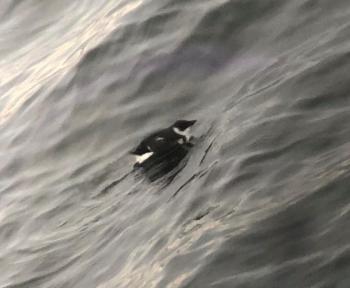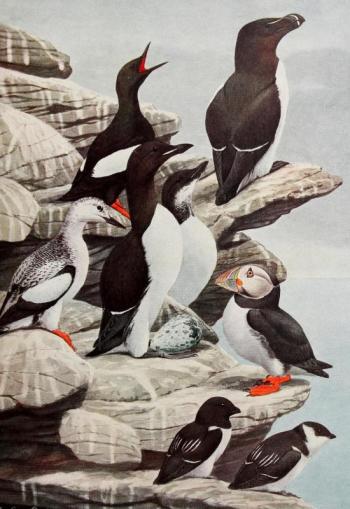Dovekie, Holy Grail of Winter Birding
It is one of the “holy grails” of winter birding. Even if you’ve seen this bird before, it’s a species you hope for whenever you find yourself peering out to sea, eyes tearing up in the icy wind, on a frigid winter day.
We’re talking about the dovekie. That wonderful name is apparently what the Swedish called the bird, and Americans liked it enough to adopt it ourselves. The Brits call it the little auk. If you don’t know the species, perhaps that name gives you a clue as to what it might look like. In our area it is indeed the smallest relative of the puffin and its other cousins in the auk family, formally known as the alcids (from the scientific family name of Alcidae). Black above and white below with a rather stubby beak, the dovekie is about the length of the familiar European starling (eight inches) and weighs about as much as a hockey puck.
Amazingly, this tiny bird is at home in the wild northern seas, where it feeds largely on tiny shrimp-like copepods. Dovekies breed along cliffs and rocky shores in the high Arctic, from Canada’s Ellsmere Island (small numbers) through Greenland to northern Scandinavia. Some of the largest colonies, numbering in the millions, occur in Greenland. In winter the birds typically move south, with largest numbers occurring from the edge of the ice pack down into waters off Labrador and Newfoundland. Smaller numbers are sometimes found south into the Gulf of Maine and farther south to offshore waters of New York, but stragglers have ended up much farther south—even in Florida, the Bahamas, and, astoundingly, to Cuba.
Reading about the history of dovekies here in Maine and throughout the northeastern U.S., you find stories of what were termed “wrecks” when dozens, sometimes hundreds, of dovekies were blown onshore and inland by long-lasting winter storms with strong, persistent winds blowing from the east. Such “wrecks” in our area seem to now be a thing of the past; the last one that involved many birds being picked up across the state seems to have been in the 1970s. There is at least one story of a birder at that time who picked up five at locations across the Pemaquid Peninsula and released them in one of the local harbors.
The past few years have seen an uptick in sightings of dovekies along the Maine coast, with many birders delighted to be able to see and watch them up close. Just last week a report came in from several boat trips off the New Hampshire/Maine coast of literally thousands of dovekies just offshore. That’s a number that is virtually unprecedented in our area except for one exceptional count of several thousand on the Eastport Christmas Bird Count back in the 1970s.
Unfortunately, the dovekies that people are seeing near shore are likely birds that are having trouble finding the food they are accustomed to or are weakened for some other reason. Apparently, the sea ice off Labrador has been very slow to develop this year, according to reports we’ve seen from satellite photos. We also know that ocean temperatures have been trending higher in recent years as a result of climate change. The Gulf of Maine itself is said to be one of the faster warming marine systems, and we know things have changed greatly: How we miss the winter shrimp we used to be able to buy from trucks parked along the snowy roads throughout Maine not that many years ago.
Are the dovekies here because they are suffering from lack of food farther north as a result of these changes? Nobody really knows, as these birds are difficult to study in winter, as you can imagine.
Whatever the reason, if you are lucky enough to see a dovekie, enjoy watching this little visitor from the Arctic. When you are back home, do what you can to help in the efforts to protect it and our oceans and lands by supporting climate change solutions at all levels, from local to state to national to international.
Jeffrey V. Wells, Ph.D., is a Fellow of the Cornell Lab of Ornithology. Dr. Wells is one of the nation's leading bird experts and conservation biologists and author of “Birder’s Conservation Handbook”. His grandfather, the late John Chase, was a columnist for the Boothbay Register for many years. Allison Childs Wells, formerly of the Cornell Lab of Ornithology, is a senior director at the Natural Resources Council of Maine, a nonprofit membership organization working statewide to protect the nature of Maine. Both are widely published natural history writers and are the authors of the book, “Maine’s Favorite Birds” and “Birds of Aruba, Bonaire, and Curaçao: A Site and Field Guide” from Cornell Press.































